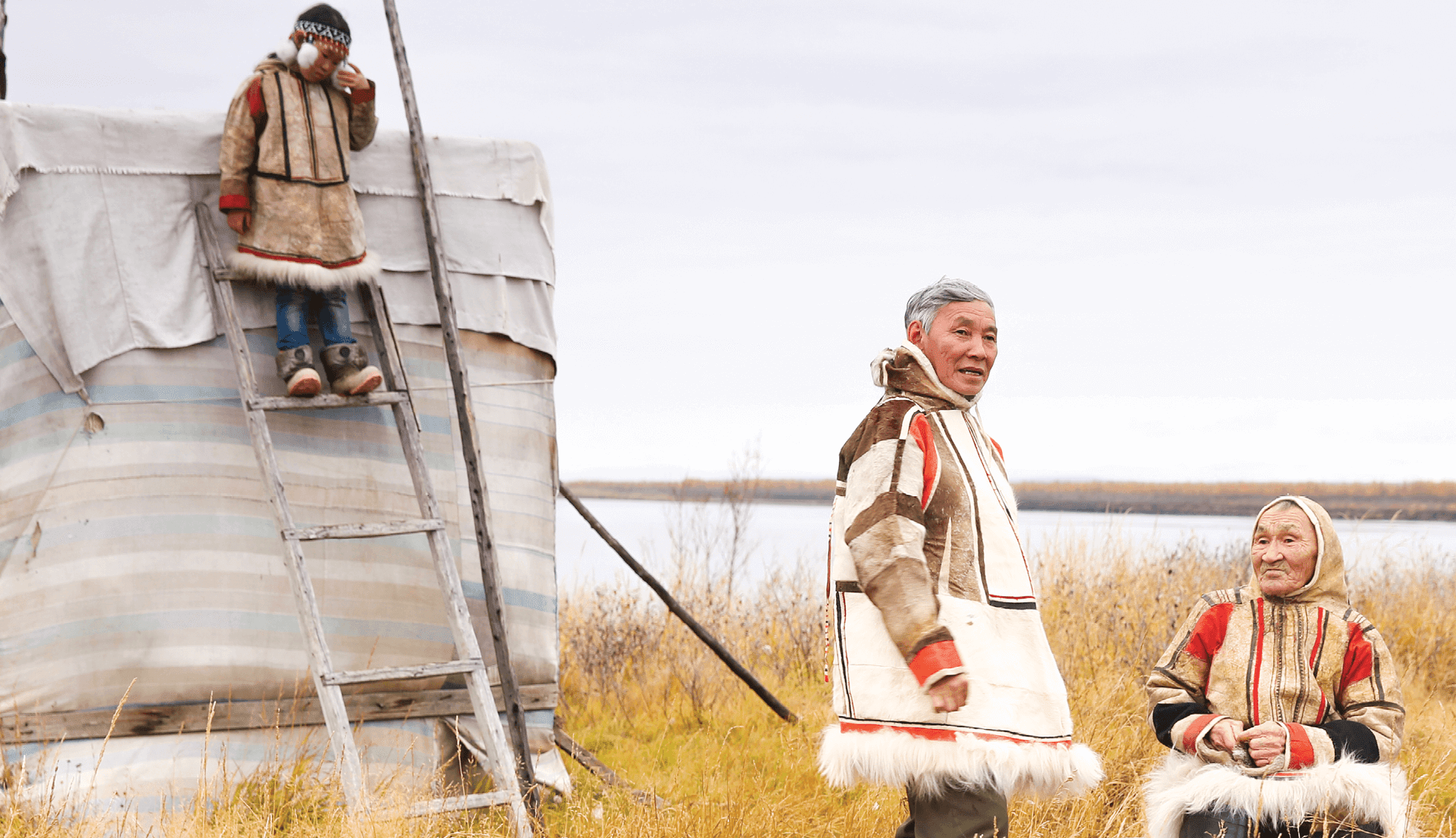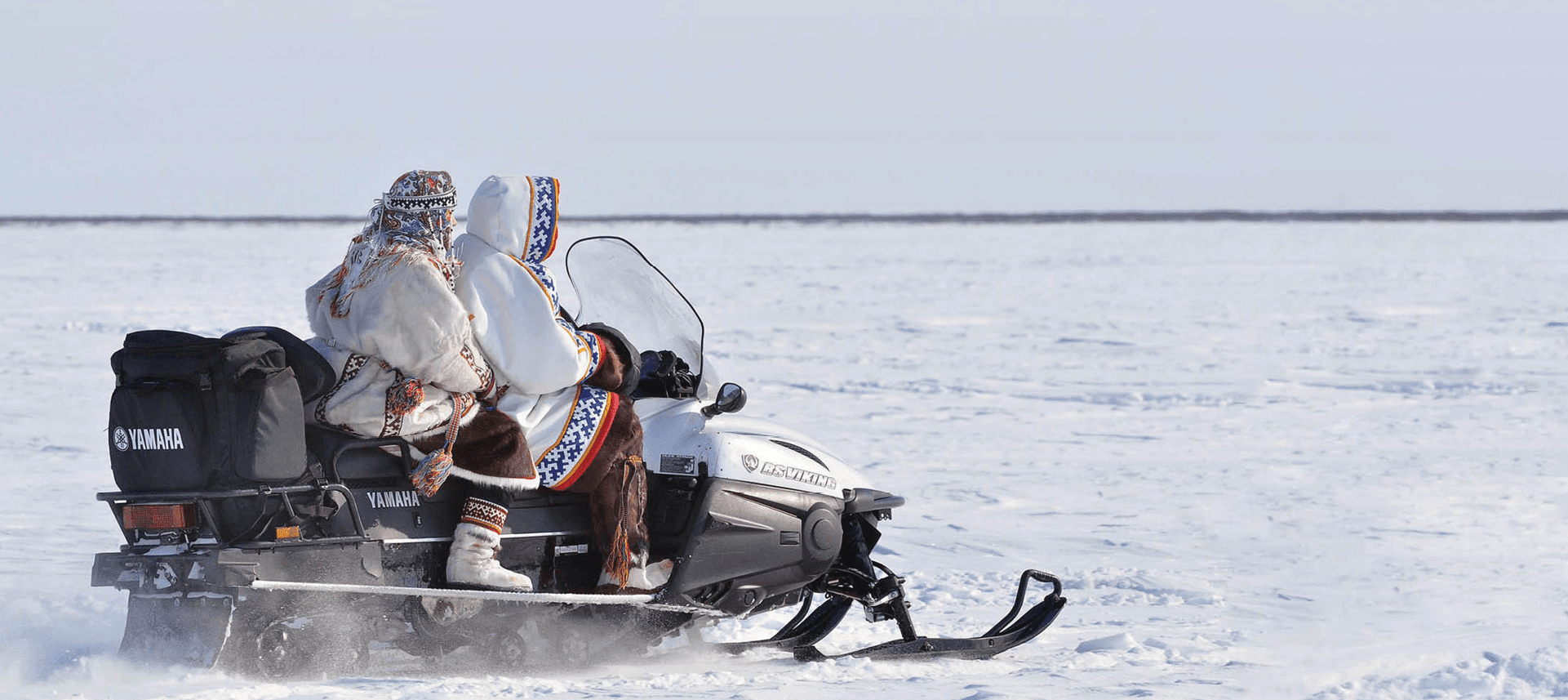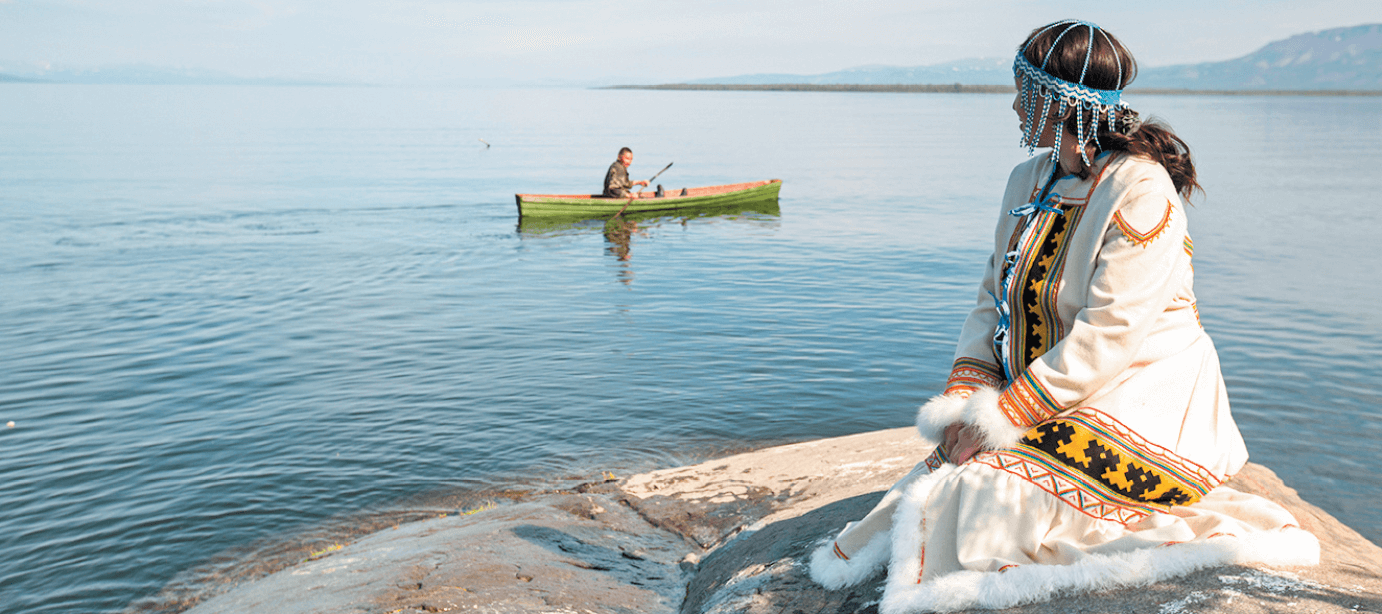Rights of local and indigenous communities
Rights of indigenous peoples
CHRB D.3.5, ICMM PE 3.6Nornickel started operating in 1935 in the town of Norilsk. Today, the Company’s key operations are concentrated within the perimeter of the existing assets, and, in some cases, they have an impact on the lives of indigenous peoples. Nornickel respects the rights, lands, economic activities, traditional culture, historical heritage and interests of indigenous peoples, and directs its efforts towards strengthening and developing neighbourly relations.
Nornickel runs a due diligence system designed to assess the impacts of the Company’s new industrial projects and sustainability initiatives on the rights and lifestyles of indigenous peoples. In addition to that, there are dedicated independent procedures to review the grievances of indigenous communities on FPIC arrangements and preparations for the development of the Kolmozerskoye deposit (Murmansk Region) without the Company’s interference.
Free, Prior and Informed Consent
CHRB A.1.3.a, IRMA 2.2.2.2, ICMM PE 3.2, ICMM PE 3.7Free, Prior and Informed Consent (FPIC) is a right enshrined in the United Nations Declaration on the Rights of Indigenous Peoples (UNDRIP) and Convention No. 169 of the International Labour Organisation (ILO) whereby indigenous communities can give or withdraw their consent to projects which can affect the interests, habitats and cultural heritage of such communities. FPIC enables indigenous peoples to have a say in decisions on project development, implementation, monitoring and assessment parameters.
Nornickel was the first company to launch the Free, Prior and Informed Consent process in the Russian Arctic with respect to the relocation of Tukhard residents from a sanitary protection zoneIn line with the existing legislation, people may not reside within the boundaries of sanitary protection zones and therefore cannot apply for permanent registration there. and further development of the respective area. The sanitary and living conditions of this community did not meet the requirements of applicable Russian laws. Hence, the Company proposed building a new settlement so that the local residents could relocate there. Tukhard residents agreed to join the FPIC procedure subject to certain conditions, including the decision whether they will relocate or not, choosing the site for their new settlement and determining its social infrastructure, selecting the best architectural designs as part of an architectural competition, as well as participation in all stages of the relocation programme through the elected Council of Representatives of the settlement residents.
The FPIC procedure was carried out in full respect for the culture and customary decision-making processes of the Nenets people, indigenous minorities residing in Tukhard. The Company does not only seek to offer local residents safer and more comfortable living conditions, but also to contribute to the preservation of the traditional lifestyle and ethnic identity of indigenous communities.
Going forward, Nornickel intends to maintain an ongoing dialogue and look for compromises with the Sámi people, an indigenous minority occupying an area where the Company and its partners plan to develop a lithium deposit (Kolmozerskoye deposit, Lovozero District, Murmansk Region). Considering that the interests of indigenous people may be affected, the Company might use lessons learned from the relocation of Tukhard’s residents to apply the FPIC procedure once again in 2023.
To ensure effective engagement with indigenous peoples, Nornickel’s Polar Division established the Coordinating Council of MMC Norilsk Nickel for Interacting with Family (Tribal) Communities of Indigenous Northern Minorities. Today, the Council brings together 53 tribal communities.
In 2021–2022, the World of Taimyr grant competition helped implement numerous projects for the preservation of long-standing traditions and for the development of territories where the Taimyr Peninsula indigenous minorities traditionally reside.
In 2020, we signed a Cooperation Agreement with the associations of indigenous peoples of the Russian Federation, Krasnoyarsk Territory, and Taimyrsky Dolgano-Nenetsky Municipal District.
Nornickel and the Peninsula’s indigenous communities are running joint programmes to support traditional trades, healthcare, housing arrangements, education, culture, sports and tourism, with total financing coming in at more than RUB 2 bn.
Improving the living standards for local communities
ICMM PE 9.1The Company pays close attention to the development of infrastructure in the regions where it operates, including by implementing the following projects:
- renovation of Norilsk’s housing, upgrade of the utilities network, urban improvements, and development of social infrastructure;
- healthcare, culture, education, and sports projects, and initiatives to improve the urban environment in Monchegorsk, Zapolyarny and Nickel;
- culture, education and utilities projects in the Gazimuro-Zavodsky District, cultural and sports events, promotion of children's and youth sports and other initiatives in the Trans-Baikal Territory;
- construction of a fibre optic communication line in Norilsk to provide local residents with a stable internet connection;
- implementation of the Corporate Healthcare project (for more details, please see the Basic Employee Rights section.
In 2022, Nornickel's key programmes and initiatives aimed at improving the well-being of local communities included:
- World of New Opportunities, a charitable programme designed to support and promote public initiatives, develop social partnerships, introduce new social technologies and foster soft skills among local communities (in 2022, the World of New Opportunities programme counted around 40,000 participants from the Company’s regions of operation);
- Plant of Goodness, a corporate volunteering programme bringing together the Company’s expertise and its vast track record of social and environmental initiatives (in 2022, over 3,500 corporate volunteers were involved in more than 370 initiatives implemented as part of local community projects);
- programmes to support sports and fitness (in 2022, the sporting and fitness events drew a total of 24,000 employees, while corporate competition streams garnered over 60,000 views).
Key dimensions of the World of New Opportunities programme in 2022
Ethnic groups of indigenous peoples in the regions of the Company’s operation
Sámi
The Sámi, also called Lapp (a group of Finno-Ugric peoples), come from the ancient inhabitants of Europe. The Sámi are first mentioned at the end of the 8th millennium BC, when people from the North first settled on the coast of Fennoscandia.
What is special about the Sámi as an ethnic group is the fact that the traditional habitat of the Sámi population is currently part of several sovereign states, i.e. Norway (40,000 to 60,000 people), Sweden (17,000 to 20,000 people), Finland (6,000 to 8,000 people) and Russia (1,500 people). Currently, the majority of the Russian Sámi live in the Lovozero District, Murmansk Region.
The Sámi of the Kola Peninsula are a standalone ethnographic group called the Kola Sámi (or the Lapp). They belong to the economic and cultural type known for a combination of reindeer herding, fishing, hunting and a semi-nomad life turning into a sedentary one in the recent decades.
In Ancient Rus, the Sámi worshipped natural phenomena, trees and mountains, and they were thought to be noaidis (shamans) and soothsayers. Sámi fishermen still toss coins into rivers so that water spirits would grant them a rich haul of fish.
The principal social and economic unit of the Sámi is the siida, a local community.
Dolgans
The Dolgans are an indigenous people of the north of the Krasnoyarsk Territory. The majority of them live along the banks of the Kheta and Khatanga rivers of the Taimyrsky Dolgano-Nenetsky Municipal District. The Dolgans are considered to be the northernmost Turkic-speaking ethnic group. Their number is 8,200 people.
The Dolgan ethnic group was formed in the 19th – early 20th century embracing Evenks and Yakuts who moved there in the 18th century, and also local Evenks, some families of Enets and Zatundra peasants.
The traditional Dolgan livelihoods include nomad reindeer herding, hunting wild reindeer, fur trapping and fishing. In summer, the Dolgans can be found in the tundra with their reindeer herds, and in winter they move to the tundra forest belt. In present-day conditions, the Dolgan reindeer herding is developing as a collective production industry, and also as part of tribal and family enterprises. After a lot of the Dolgans turned to a sedentary life in the second half of the 20th century, their standalone families have been living in settlements made up of tract houses.
The Dolgans are good at arts and crafts, they make beads jewellery and decorate clothes and footwear with reindeer fur and beads. Reindeer and mammoth bone carving is quite popular among them.
The Dolgans belong to Tengrism, Shamanism and Russian Orthodox faiths.
Currently, the Dolgans are among the most urbanised peoples of Taimyr.
Nenets
The Nenets are a Samoyedic people of Russia living on the Eurasian coast of the Arctic Ocean from the Kola Peninsula to Taimyr. The daily life of the Nenets has remained unchanged for 8,000 years.
The Nenets consist of two ethnic subgroups, the European and the Asian (Siberian) Nenets. The European Nenets reside in the Nenets Autonomous Area of the Arkhangelsk Region, and the Siberian Nenets can be found in the Yamal-Nenets Autonomous Area and in the Taimyrsky Dolgano-Nenetsky Municipal District, Krasnoyarsk Territory. Smaller groups of the Nenets live in the Khanty-Mansi Autonomous Area, Murmansk and Arkhangelsk regions, and also in the Republic of Komi.
The Nenets are also divided into the tundra and the forest ones, which speak different languages.
From among the indigenous peoples of the Russian North, the Nenets are the most numerous one, with their number reaching 49,600 people.
The traditional Nenets livelihood is reindeer herding in large herds. On the Yamal Peninsula, there are several thousand nomad Nenets herding about 500,000 reindeer.
The traditional Nenets housing is a conical yurt (mya). One mya is made of 40 poles covered with reindeer hides. Inside the yurt, each item and each place have their purpose assigned to them in the ancient times.
The Nenets faith is Shamanism. They believe that trees, mountains, lakes and rivers are inhabited by spirits.
Enets
The Enets are a Samoyedic indigenous people living in Russia. They are first mentioned back in the 15th century. The ethnogenesis of the Enets embraces both local tribes of Northern Siberia and the Samoyeds coming from the mid-Yenisey territory and from the Tom River basin and assimilating the local population.
The number of the Enets in Russia is 201 people. They mainly live in the Taimyrsky Dolgano-Nenetsky District. Despite the small number, the Enets are divided into two ethnic groups, the tundra and the forest ones, based on their settlement area, language and culture.
As regards the language and culture, the Enets are close to the Nganasans and the Nenets.
The Enets’ principal dwelling is a conical yurt similar to that of the Nenets but smaller in terms of the covering.
The basic Enets’ livelihoods are sedentary reindeer herding, hunting wild reindeer, fur trapping and fishing.
Currently, most of the young Enets people work in institutions of Taimyr settlements, and a minor part are engaged in traditional hunting and reindeer herding. Among the today’s tundra inhabitants, Enets-Nenets families account for about 50%; as for the forest Enets, they have more than 70% mixed families.
Nganasans
The Nganasans are a Samoyedic indigenous people living in Siberia. They are the northernmost in the entire Eurasia, and one of the oldest indigenous people in the Arctic. They come from the most ancient population of Taimyr, Neolithic hunters.
Currently, the Nganasans inhabit the east of the Taimyrsky Municipal District, Krasnoyarsk Territory, and a territory managed by the municipal authorities of Dudinka. The Nganasans are divided into the western ones, the Avam Nganasans, with the centres in the settlements of Ust-Avam and Volochanka of Dudinka, and the eastern ones, the Vadeyev Nganasans, with the centre in the Novaya settlement of Khatanga. Their differ in their family and tribe compositions and dialect features of the language. The number of the Nganasans registered in Russia is 687.
By now, most of the Nganasans have turned to non-traditional activities in stationary settlements. Reindeer hunting, fur trapping and fishing remain relevant for a minor part of them. The Nganasan women make leather out of reindeer hides. They also make national footwear, souvenir rugs, handicraft, and fur clothes for their hunters and fishermen. In the settlement of Volochanka, women work at the blue fox fur farm.
Among the religious Nganasans, there are both Orthodox Christians and adepts of the traditional cult.
Evenks
The Evenks (formerly Tungus) are an indigenous people of the Tungusic group living in Eastern Siberia. Their origin is traced back to the 1st millennium AD, when the local population of Eastern Siberia mixed with the Tungus tribes coming from Cisbaikalia and Transbaikalia. Several economic and cultural types of the Evenks formed as a result.
Currently, the Evenks inhabit quite a large territory, from the coast of the Sea of Okhotsk in the east to the Yenisey River in the west, from the Arctic Ocean in the north to Cisbaikalia and the Amur River in the south; outside Russia, the Evenks live in Manchuria (China) and Mongolia. The number of the Evenks registered in Russia is 39,226 people. About 50% of them live in Yakutia, 10% in the Krasnoyarsk Territory, another 10% in the Khabarovsk Territory, and the rest in Buryatia, Amur Region, Irkutsk Region, and Trans-Baikal Territory.
The principal livelihoods of the Yenisey Evenks are taiga reindeer herding, hunting, and to a lesser extent seasonal fishing. The Evenks also developed cattle farming traditions adopted by southern groups of the Evenks from Mongolian groups.
The handicraft of the Evenks includes artistic bone and wood carving, metal working, beading, embroidery in silk, appliqué in fur and fabric, and birch bark embossing.
Komi
The Komi (formerly Zyrian) are a Finno-Ugric people living in Russia, the indigenous population of the Republic of Komi. There are 143,500 Komi in Russia, with most of them living in the Republic of Komi. The Komi also live in the Arkhangelsk, Murmansk, Kirov and Omsk regions, as well as in other regions of Russia, in small enclaves and mixing with the local population.
Their main ethnographic groups are Komi of the Vychegda River, Komi of the Vym River, Komi of the Izhma River, Komi of the Pechora River, Komi of the Luza River, Komi of the Sysola River and Komi of the Vashka and Mezen Rivers.
Their direct ancestors are ethnic-territorial groups of the Vychegda Perm, which were formed back in the 10–14th centuries based on the local tribes of hunters and fishermen as a result of their active contacts with Perm tribal groups coming from the Upper Kama River area. The ethnogenesis of the Komi was influenced by a number of neighbouring peoples, including the Veps, ancient Mari, ancestors of the Ob River Ugrians, East Slavs and others.
The Komi’s traditional livelihood is arable farming (barley and rye). For their personal needs, they raised cattle, sheep and horses. The northern Komi (those of the Izhma River) herded reindeer, adopting this activity from the Nenets in the 17th century. Other ethnic groups of the Komi also engaged in fur trapping and fishing for valuable species of fish and traded in the respective products. Their ancillary activities included berrying, nutting, and preserving birch sap and mushrooms (except for the Komi of the Izhma River). As for indoor activities, the Komi engaged in weaving, spinning, dyeing homespun cloths, cloth printing, dressing furs, making suede and footwear, hooping, and making spoons and mats.
The traditional Komi house is a log cabin on a high basement. In southern regions, they usually made one-storeyed houses. The northern Komi built two-storeyed houses at the end of the 19th century.
Most of the Komi are Orthodox Christians (since the end of the 14th century), some of them are Old Believers.



